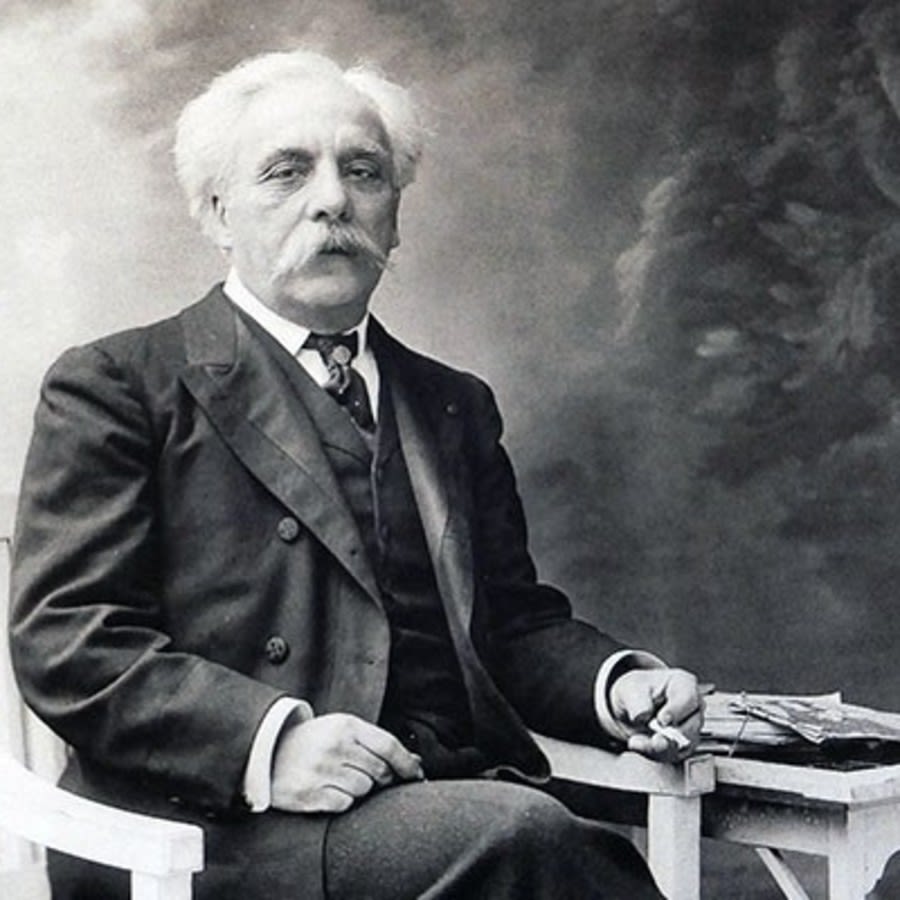
Thank you for joining us.
It is a real joy to see the London Symphony Orchestra return to concert performances at LSO St Luke's this autumn. A warm welcome to the numerous guest conductors and artists who will join the LSO in the Jerwood Hall over the coming months, and welcome back to our family of conductors: Sir Simon Rattle, Gianandrea Noseda, François-Xavier Roth and today's guest conductor Duncan Ward.
We are grateful for the support of Art Mentor Foundation Lucerne and our Technical Partner, Yamaha Professional Audio, in aiding the LSO's return to work.
It is a pleasure to invite you to watch and listen today. I hope you enjoy the performance, and that you are able to join us again soon.

Kathryn McDowell CBE DL; Managing Director
Kathryn McDowell CBE DL; Managing Director
Sunday 6 September 2020
Bernstein, Fauré, Berlioz & Gershwin
Bernstein Three Dance Episodes from 'On the Town'
Fauré arr Rabaud Dolly Suite
Berlioz Scène d'amour from 'Romeo and Juliet'
Gershwin arr Berkowitz Promenade (The Real McCoy; Walking the Dog)
Gershwin arr Rose Overture: Strike up the Band
Duncan Ward conductor
Visit our website for information on how we are ensuring activity at our venue LSO St Luke’s is COVID-19 secure.
The support of our audience has truly never been more important for the Orchestra and its world-class artistic programme. By supporting us now and in the months to come, you will help us to continue to adapt our music-making and activities to meet the challenges of these times, including sharing the gift of music with our local communities through our LSO Discovery programme.
Duncan Ward conducts the London Symphony Orchestra in a specially-recorded concert for the Festival d'Aix-en-Provence, where the Orchestra was due to be resident in July 2020 before the lockdown and travel restrictions were put in place due to Covid-19. The concert was instead recorded at LSO St Luke's in London and was originally shown on Arte TV in France in July.
Today's programme brings us on a journey to and fro to two of the world's most fascinating cities, New York and Paris, exploring the music of composers who broke new ground in their work.
Bernstein
Three Dance Episodes
from 'On the Town'
1944

1. Dance of the Great Lover
2. Pas de Deux
3. Times Square Ballet
Bernstein had a rapacious love of all styles of music, blurring boundaries of musical genres, and had no issues incorporating 'popular' into classical styles. It's impossible to listen to his jazzy beats without some serious foot-tapping in his musicals and On the Town is no different. The place: New York; the plot: three sailors have just 24 hours to see the whole of the city. Needless to say, those classy city dames soon become the main attraction.
On the Town (not to be confused with the equally fabulous Wonderful Town) was based on Bernstein’s successful ballet, Fancy Free, and, as Bersntein wrote: 'it seems only natural that dance should play a leading role in the show'. In Dance of the Great Lover, romantic Gabey dreams of sweeping Miss Turnstiles off her feet, the frenetic music conjuring up the bustling, restless, crowded city. The Pas de deux uses the gorgeous Lonely Town melody, full of yearning and melancholy. Times Square Ballet embraces a bluesy, sensual riff on the New York, New York ('It’s a Helluva Town') theme, alongside a sense of urgency of living life in the fast lane during those short 24 hours.
Note by Sarah Breeden
Leonard Bernstein
1918-1990

The son of a Russian business man in New York City, it was at the age of ten that Leonard Bernstein first played the piano, and subsequently went about earning his own money to fund piano lessons – a hobby that his father initially saw as frivolous and refused to support. When Bernstein showed immense talent, he gained the support of his father and later attended Harvard University and subsequently the Curtis Institute of Music in Philadelphia to study music and further strengthen his musical skills. In the summer of 1940, at the age of 22, he attended Berkshire Music Center at Tanglewood where he was one of only five students chosen for a conducting masterclass with the famed Serge Koussevitzky.
A stroke of luck later attributed to Bernstein's next milestone when he was offered the position of assistant conductor at the New York Philharmonic. When the orchestra's guest conductor fell ill on 14 November 1943, Bernstein stepped up to the podium and amazed both orchestra and audience, resulting in rapturous applause and a front page article in the New York Times.
In composition, he became known for an ability to blend the divide between classical and popular idioms, with works combining jazz, theatre and classical forms. Whether writing for small ensembles, symphony orchestras, Broadway, film or opera houses, Bernstein always sounded like 'Bernstein', having established a sound that has become synonymous with American music. His most acclaimed works include West Side Story, On the Town and Candide, Fancy Free, Facsimile and The Dybbuk .
Fauré arr Rabaud
Dolly Suite
1896

1. Berceuse Allegretto moderato
2. Mi-a-ou Allegro Vivo
3. Le jardin de Dolly Andantino
4. Kitty-valse Tempo di Valse
5. Tendresse Andante
6. Le pas espagnole Allegro
It's often difficult to know what to give as birthday presents but Fauré had the answer literally at his finger tips: the six short pieces, often adapted from previous works, that make up the suite were given to a young friend as gifts for various family celebrations over a number of years. The lucky recipient was the daughter of Emma Bardac, Fauré's lover; it was rumoured that Dolly was his daughter. Whatever the truth – and his female conquests were legendary – Fauré enjoyed a burst of renewed creativity during his late 40s at the time of their relationship.
Originally written for 'Four hands' or piano duet, this popular work has enjoyed various arrangements including the one performed today for orchestra by Henri Rabaud in 1906.
The first, Berceuse, is the most famous of all the movements, its rocking melody appropriate for the meaning of the title, 'cradle song'. You could be forgiven for thinking Mi-a-ou is about a feline friend, but, in fact, imitates two-year-old Dolly's attempt to say her older brother's name. After a refreshing walk around Dolly's garden, often referred to as the jewel in the Suite's crown, Kitty-valse pokes fun at a pet dog. Tendresse encapsulates a more mature mood, and, indeed, was originally dedicated to another potential love conquest, the wife of his publisher. Flourishes on castanets and tambourines herald the finale, a trip to the sunny Spanish shores.
Note by Sarah Breeden
Gabriel Fauré
(1845-1924)

Gabriel Fauré was a French composer, organist, pianist and teacher who showed so much promise as a child, that he was enrolled to the École de Musique Classique et Religieuse in Paris, not by his parents but by the composer Louis Niedermeyer who could see much potential in the 9 year old. Fauré is best known for his Requiem, which in 1888, after almost 20 years of work, received its first performance.
In 1892, Fauré was appointed Inspector of Music in Paris. By then he had begun an affair with Emma Bardac, who later became Debussy’s wife. In 1896 he was appointed professor of composition at the Paris Conservatoire. During his 25 years in the position, he taught an extraordinary list of pupils including Ravel and Nadia Boulanger. Behind his success, Fauré experienced increasing deafness and aural hallucinations. He died in 1924 from pneumonia.
Berlioz
Scène d'amour from 'Romeo and Juliet'
1839

One evening in Paris, Berlioz, an aspiring young composer, witnessed a performance of Hamlet by an English company, a momentous evening in more ways than one, as two fiery passions were ignited: Shakespeare, and a certain Miss Harriett Smithson, the young Irish actress playing Ophelia. Initially rejected by Harriett, Berlioz – being one for heightened passions – did not give up and eventually they married, albeit not very successfully.
The Bard initiated a more fortunate outcome, and was the inspiration for several works including Beatrice and Benedict and King Lear Overture. Romeo and Juliet, composed some 15 years after that fateful evening, is a large-scale choral symphony loosely based on the play. Scene d’amour is the beating heart of the work, one of heightened emotions between the two young lovers. Although a 'choral symphony', Berlioz elected to not give the two main characters voices because he felt that instrumental language to be 'richer, more varied, less finite, and through its very imprecision incomparably more powerful in such a situation'. Comprising of three themes, one for Romeo, one for Juliet and one for the pair with contrasting passages, Berlioz declared it one of his favourite pieces.
Note by Sarah Breeden
Hector Berlioz
(1803-1869)

Born in the southeastern region of Isère in France, Hector Berlioz was entranced with music as a child, learning to play flute and guitar, and later becoming a self-taught composer by the age of twelve. Following in his father's footsteps, he went to Paris to study medicine but having spent much of his time at the Paris-Opéra, he left medicine behind to become a composer and in 1826 enrolled at the Paris Conservatoire. The following year he came across Irish actress Harriet Smithson, who inspired one of his most famous works: the Symphonie fantastique, a piece that broke new ground in Romantic orchestral expression.
Following three unsuccessful attempts, he won the Prix de Rome in 1830. But it was throughout this decade that he relied on music criticism and his new appointment as deputy librarian at the Paris Conservatory to earn a living. He later found financial stability with extensive tours throughout Europe and in the 1850s, when he was elected to the Institut de France, he was entitled to a stipend. During this period he wrote Les Troyens, inspired by Virgil's Aeneid, and returned to William Shakespeare with the opera Béatrice et Bénédict (based on Much Ado About Nothing), which had a successful debut in Germany in 1862.
Following more European tours, the break down of his first marriage and the death of his second wife, Berlioz returned to Paris in 1868. The following year, at the age of 65, he died in Paris and left behind many innovative compositions setting the tone for the Romantic period.
Gershwin arr Berkowitz
Promenade (The Real McCoy; Walking the Dog)
1937

Like his fellow-American Bernstein, George Gershwin was influenced by many styles of music but is possibly best known for his jazz-inspired numbers, including Rhapsody in Blue, An American in Paris and his opera Porgy and Bess from which Summertime has become a standard. With his brother Ira as lyricist, he also composed big Broadway hits such as Girl Crazy.
He didn't write much film music – who knows what might have been if he hadn't died at the tragically early age of 38 – but Fred Astaire and Ginger Rogers fans can’t fail to recognise Promenade from the 1937 film Shall We Dance. The two protagonists are seen not dancing, but walking posh pooches on a luxury ocean liner before ending up walking with each other. Sol Berkowitz arranged it into the jaunty version heard today, with a perky jazz clarinet taking centre stage. The work also made an appearance in the 1974 ballet The Real McCoy.
Note by Sarah Breeden
Gershwin arr Rose
Overture: Strike up the Band
1927

Mention Strike up the Band and film fans may also immediately think of the 1940 'Let’s put on a show, kids' movie starring fresh-faced juveniles Micky Rooney and Judy Garland. The Overture, in fact, is from Gershwin’s 1927 musical of the same name, that bears no relation to the later movie apart from the incidental music.
The musical itself, inspired by Gilbert and Sullivan, is a mad-cap affair about an over-zealous American patriot who wants to declare war on Switzerland (cheese has a lot to answer for). It was not a success and is all but forgotten; the Overture, full of pep and pizzazz, has survived as a popular concert staple.
Note by Sarah Breeden
George Gershwin
(1898-1937)

George Gershwin was born in Brooklyn and began his musical training at thirteen. Just two years later he left high school to work for a music publisher as a pianist and 'song plugger' (a musician employed to promote new sheet music). Soon, he was writing his own songs and in the 1920s, George and his older brother Ira became leading Broadway songwriters.
The Gershwin Brothers' extraordinary collaboration led to 22 musical comedies, among them Lady, Be Good! (1924), Funny Face (1927) and Of Thee I Sing (1931), the first musical comedy to win a Pulitzer Prize.
In 1924, George was asked to write for a special concert at the Aeolian Hall in New York. Busy writing a musical at the time, Gershwin managed to pull together a work called Rhapsody in Blue, a work that would catch the public’s attention in a new era of music.
By 1937 George was at the height of his career. His symphonic works and three Preludes For Piano were becoming part of the standard repertory for concerts and recitals, and his songs had brought increasing fame and fortune. It was in Hollywood however, while working on the score of The Goldwyn Follies, that George Gershwin sadly collapsed and died of a brain tumour.
Artist Biographies

Duncan Ward
conductor
© Askonas Holt
© Askonas Holt
British conductor Duncan Ward has established himself as one of the most exciting and versatile conductors of his generation. The beginning of the 2019/20 season saw Duncan give the German premiere of Brett Dean's acclaimed Hamlet at Cologne Opera, met with critical acclaim, and in January 2020, he was appointed by Festival d’Aix-en-Provence as Music Director of the Mediterranean Youth Orchestra.
From 2012-14 he was Conducting Scholar of the Berliner Philharmoniker Orchester-Akademie, to which he was appointed on the recommendation of Sir Simon Rattle. He also held the post of Associate Conductor of the National Youth Orchestra of Great Britain.
Also an accomplished composer – Duncan was winner of the 2005 BBC Young Composer of the Year and is now published by Peters Edition.
London Symphony Orchestra
On Stage:

Leader
Carmine Lauri
First Violins
Clare Duckworth
Laura Dixon
Maxine Kwok
Elizabeth Pigram
Harriet Rayfield
Sylvain Vasseur
David Alberman
Alix Lagasse
Csilla Pogany
Second Violins
Julián Gil Rodríguez
Thomas Norris
Sarah Quinn
Miya Vaisanen
Matthew Gardner
Naoko Keatley
Belinda McFarlane
Iwona Muszynska
Violas
Edward Vanderspar
Malcolm Johnston
Anna Bastow
German Clavijo
Julia O'Riordan
Robert Turner
Cellos
Rebecca Gilliver
Alastair Blayden
Jennifer Brown
Daniel Gardner
Amanda Truelove
Double Basses
Colin Paris
Patrick Laurence
Matthew Gibson
Joe Melvin
Flute
Gareth Davies
Julian Sperry
Piccolo
Sharon Williams
Oboes
Juliana Koch
Olivier Stankiewicz
Cor Anglais
Rosie Jenkins
Clarinets
Chris Richard
Chi-Yu Mo
Bass Clarinet / Saxophone
Howard McGill
Bassoon
Daniel Jemison
Dominic Tyler
Lawrence O'Donnell
Contra Bassoon
Fraser Gordon
Horns
Roger Montgomery
Angela Barnes
Alex Wide
Jonathan Maloney
Trumpets
Niall Keatley
Robin Totterdell
Simon Cox
Trombones
Rebecca Smith
James Maynard
Bass Trombone
Paul Milner
Tuba
Ben Thomson
Timpani
Nigel Thomas
Percussion
Neil Percy
David Jackson
Sam Walton
Tom Edwards
Harp
Bryn Lewis
Piano
Catherine Edwards
Thank You for Joining Us
The support of our audience has truly never been more important. You can help us to continue to adapt our music-making and activities to meet the challenges of these times.
You can also donate now via text.
Text LSOAUTUMN 5, LSOAUTUMN 10 or LSOAUTUMN 20 to 70085 to donate £5, £10 or £20.
Texts cost £5, £10 or £20 plus one standard rate message and you’ll be opting in to hear more about our work and fundraising via telephone and SMS. If you’d like to give but do not wish to receive marketing communications, text LSOAUTUMNNOINFO 5, 10 or 20 to 70085. UK numbers only.
Thank you.
Keep Exploring
- Subscribe to our YouTube channel, where you can watch over 500 videos, including new music released every Sunday.
- Follow us on Facebook, Instagram and Twitter for quizzes, listening suggestions and more.
- Find us on Apple Music to listen to all our recordings.
- Sign up to our email list to be the first to hear about our latest news and programmes.
Keep scrolling for details of our next YouTube broadcast...
Friday 18 October, 7pm
Strauss, Hannah Kendall & Bartók
Strauss Le bourgeois gentilhomme – Suite
Hannah Kendall The Spark Catchers
Bartók Dance Suite
Kerem Hasan conductor

